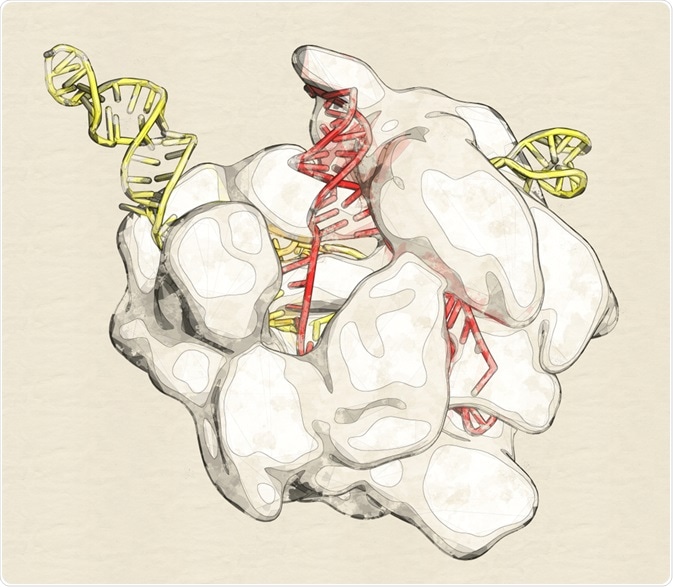CRISPR-Cas14: Discovery, Function, Advantages
CRISPR-Cas14 is a variation of the CRISPR-Cas gene editing system which benefits from being simpler and smaller than the other versions. The newly discovered system is currently being applied to the broad field of CRISPR diagnostics – both for infectious and non-infectious diseases.
Skip to:
- CRISPR-Cas
- The discovery of CRISPR-Cas14
- What is Cas14?
- Cas14 compared to the other Cas enzymes
- Advantages of Cas14
 molekuul_be | Shutterstock
molekuul_be | Shutterstock
CRISPR-Cas
The CRISPR-Cas system is an integral part of the prokaryotic immune system that helps to provide resistance to the genetic elements present in plasmids and phages. CRISPR is short for clustered regularly interspaced short palindromic repeats and Cas9 refers to CRISPR-associated protein 9.
This system is present in bacteria where it captures segments of DNA from the viruses that invade them and create CRISPR arrays. This array helps the bacteria to remember the viral sequence and in case reattack of the virus, the bacteria can produce these RNA segments from the array of CRISPR and target the viral DNA. In a way, it can be considered a bacterial immune system.
The discovery of CRISPR-Cas14
Although several enzymes behind the CRISPR-Cas defense mechanism have been discovered, it is being realized that there are several variations of the protein. Thus, Jennifer Doudna's lab investigated if other and simpler forms of Cas systems were present. They investigated this by creating a database of microbial genome and metagenome to search for uncharacterized cas genes.
Subsequently, they found several Cas genes, such as cas1, cas2, cas4, and cas14. The cas14 codes for a smaller Cas protein has a weight of 40–70 kilodaltons. They have around 400–700 amino acids and are half the size of other Cas proteins.
What is Cas14?
There are 24 variants of the cas14 gene, which are clustered into three subgroups: cas14a-c. All of the Cas proteins contain a conserved a RuvC nuclease domain irrespective of sequence diversity. However, cas14 is only present in archaea, not bacteria. Thus, this gene may be more primitive than the other version of Cas proteins: cas9 and cas12. The small size of the cas14 gene suggests that it could act as a stand-alone CRISPR effector.
Cas14 compared to the other Cas enzymes
In one study, the cas14 gene was cloned along with the CRISPR array and expressed in E. coli. In the bacteria, Cas14 could bind and subsequently cleave a specific single-stranded DNA, similar to cas13 and cas12. However, this cleavage was more specific than cas12 or cas13, as it requires a specific gRNA sequence in order to function.
It was also shown that while Cas9 requires a PAM sequence, there is no such requirement for Cas14.
The discovery that Cas14 targets single-stranded DNA suggests that it may evolved to defend against single-stranded DNA viruses or mobile genetic elements that can propagate through single-stranded intermediate structures.
Advantages of Cas14
The addition of Cas14 allows double-stranded DNA, single-stranded DNA and RNA to be detected. In addition, the specificity of the Cas14 protein increases the fidelity of single nucleotide polymorphism (SNP).
It is likely that CRISPR-Cas14 will eventually be used to assist in several fields of research, such as the diagnosis of viral and microbial infections, as well as the detection and modification of cancer cells. Research suggests that this system may have been particularly effective in ecosystems which is abundant in single-stranded DNA viruses.
Sources
- Aquino-Jarquin, G. (2019). CRISPR-Cas14 is now part of the artillery for gene editing and molecular diagnostic. Nanomedicine: Nanotechnology, Biology and Medicine. doi.org/10.1016/j.nano.2019.03.006.
- Harrington, L. B., et al. (2018). Programmed DNA destruction by miniature CRISPR-Cas14 enzymes. Science. 10.1126/science.aav4294.
- NIH. (2017). What are genome editing and CRISPR-Cas9? nih.gov/primer/genomicresearch/genomeediting
Further Reading
- All CRISPR Content
- What is CRISPR/Cas9?
- CPISPR Applications
- CRISPR: Ethical and Safety Concerns
- CRISPR: The End for Zinc Fingers?
Last Updated: Jun 20, 2019

Written by
Dr. Surat P
Dr. Surat graduated with a Ph.D. in Cell Biology and Mechanobiology from the Tata Institute of Fundamental Research (Mumbai, India) in 2016. Prior to her Ph.D., Surat studied for a Bachelor of Science (B.Sc.) degree in Zoology, during which she was the recipient of anIndian Academy of SciencesSummer Fellowship to study the proteins involved in AIDs. She produces feature articles on a wide range of topics, such as medical ethics, data manipulation, pseudoscience and superstition, education, and human evolution. She is passionate about science communication and writes articles covering all areas of the life sciences.
Source: Read Full Article
